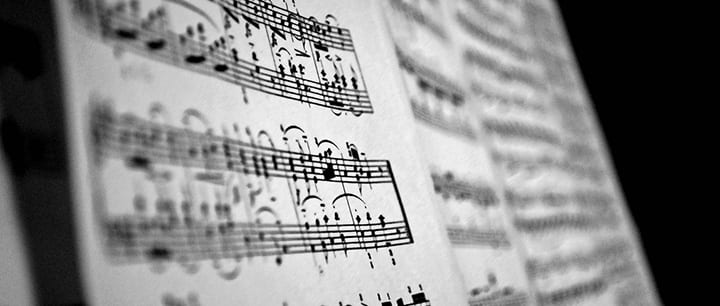So you’ve mastered and memorized all the different scales on the piano – what now? Here are some awesome musical ideas to try next, courtesy of Corona, CA teacher Milton J...
One of the best ways to improve your piano playing is to practice your scales. Once you’ve got them mastered, however, there are plenty of other things you can do to further improve your skills.
In this blog post, we’ll explore some of these things. So read on for some ideas on how to take your playing to the next level!
What Are Scales on a Piano?
When you are learning all the scales on piano, you’ll want to understand this basic information:
- A piano has 88 keys, which are divided into seven octaves.
- Each octave is further divided into 12 semitones, or scales.
- The notes on the scale for piano are based on the pitch of the previous note, which is determined by its vibration frequency.
- The size of the scale also determines the range of the piano. A smaller scale will have a higher pitch, while a larger scale will have a lower pitch.
- The most common scales used in Western music are major and minor scales.
- Major scales are made up of seven notes, while minor scales have six notes. Each scale has a unique pattern of whole and half steps between the notes.
- Scales can also be classified by their tonality, or the overall feeling of the music. Major scales are considered to be happy and upbeat, while minor scales are thought to be sad and mellow.
Piano students typically learn to play scales as part of their musical training.
Scales help to develop finger strength and dexterity, and they also provide a foundation for learning more complex pieces of music. Whether you’re hoping to learn how to play the C scale on piano or learning all the minor scales, by practicing scales regularly, pianists can improve their technique and musicianship.
Ask your piano teacher for recommendations on which scales you should be practicing and check out the video below for even more reasons to take piano lessons:
https://www.youtube.com/watch?v=kJlInwy1yBs
How Many Scales Are in the Piano?
How many scales are there on the piano and what are the major scales on piano?
There are 88 keys on a piano, and each key corresponds to a particular note. A note is simply a sound of a specific pitch, or frequency. The pitch of a note depends on the number of vibrations per second that create the sound. For example, middle C has a pitch of 264 Hz, which means that the string vibrates 264 times per second.
A scale is simply a group of notes that are played in succession. The most common scale in Western music is the major scale, which consists of seven notes. The major scale can be divided into two parts: the first half, called the diatonic scale, includes all seven notes; while the second half, called the chromatic scale, includes all 12 notes.
So, how many scales are on the piano?
Well, there are actually an infinite number of scales, because any group of notes can be considered a scale.
However, the most commonly used scales are the major and minor scales, of which there are 12.
How Do You Play All 12 Major Scales on Piano?
To play all 12 major scales on the piano, start by sitting at the middle of the keyboard with your right hand on middle C.
Then, move up one octave and play the scale starting on D. Continue moving up the keyboard, playing the scale starting on each note until you reach high C. When you’ve played all 12 scales, move down the keyboard, starting on C again and playing the scales in reverse order.
Playing all 12 major scales is a great way to improve your piano skills and increase your knowledge of music theory.
Not only will it help you to better understand how chords are built, but it will also enable you to sight-read music more easily.
So, whether you’re a beginner or a seasoned pianist, take some time to play all 12 major scales today!
5 Things To Try Once You’ve Learned All the Scales on Piano
You’ve likely come a long way from your very first piano lesson, a nerve-wracking beginning to what is sure to be a lifelong love for these 88 keys of joy and wonder. Maybe it’s been a few lessons and you’ve finally completed a goal – you’ve mastered major and minor scales! From C major to Eb minor, you’ve got the fingerings, crosses, and two-hand synchronization down. So, what’s next? Here are five new steps you can take after your scales on the piano are committed to memory.
1. Interval Training For Your Ear with Familiar Tunes
Everyone has that favorite song they are dying to learn how to play on the piano. And there’s no time like the present to use that favorite song to start teaching your ear to listen for intervals and recreate them on the piano. This skill is fundamental to understanding how harmony functions within melodic and chordal procedures and is essential to your piano-playing development. And all of this can be achieved with Here Comes the Bride and The Simpsons theme song.
This video from Home Studio Essentials shows some popular songs and rhymes that are utilized for interval ear training:
2. Reading Sheet Music Using Favorite Songs
Have you ever passed through you favorite music store and seen the books of music featuring your favorite artists? Well, now’s the time to pick out one of those books and bring it with you to your lessons! You can also ask your teacher if they possess the songbooks in question, which may save you a step and some cash. These songs will provide a fun way to further introduce you to reading musical notation, and you will most likely start to make parallels between the intervals and scales on the piano you’ve learned and the melodies used in your favorite song.
3. Writing Musical Stories
The creative process is a wonderful thing to behold. It begets the great art we’ve enjoyed for centuries, and it allows us to create even more for ourselves and for others. Why not utilize that creative spirit in creating something of your own? One of the most liberating ways is to set original stories and/or poems to music. Whether this is set to scales or music you have already learned or original melodies altogether, this could be a great way to get those creative juices flowing. Ask your teacher about making this a project for you, and maybe you can collaborate with them or even your musical friends!
While fully orchestrated instead of merely on the piano, this example of “Pickles and the Bully” from Pickles’ Adventures can give you an idea of creating musical ideas set to a story:
4. Need For Speed
Now that you have all these scales memory-banked, what else can you do with them? Well, you can turn them into speed drills! One way is to target a specific note and try to get to that note as fast as possible. For example, take the five-finger scale and try only going one direction and see just how fast you can reach your target note. Pay no mind to initial mistakes for now, as long as you play that target note strong. With even more practice, those mistakes in the middle will disappear! From there, change it to playing as light as you can. The lighter you play, the faster you can play. So, try not to push at the notes. Instead, grab at the notes and let your fingers produce a full tone, not your arms. In no time, you’ll turn those scales into speed racers!
Here are some piano finger exercises to improve speed.
5. Back to the Blues
Did you know that some of our favorite classic songs are built around a blues scale? Take “Sunshine of Your Love” by Cream. That introduction scale is a blues scale. “Heartbreaker” by Led Zeppelin? Sure enough, a blues scale. How about on the piano? Blues scales are in some of the most beloved and popular jazz standards in America. Learning blues scales across all the keys you learned in your major and minor scales will open up more improvisational possibilities, enabling you to become an even better pianist!
Steve Nixon from freejazzlessons.com gives a great video tutorial with an accompanying sheet of blues scales here:
6. Experiment With Different Rhythms and Time Signatures
One of the great things about playing piano is that there are so many different ways to experiment with sound.
Once you’ve mastered the basic scales, you can start to play around with different rhythms and time signatures. This can be a great way to add interest to your playing, and it can also help you to develop your sense of timing and rhythm. There are a few different ways to go about experimenting with different rhythms.
One way is to simply vary the tempo of your playing. Another way is to play with different accent patterns, or to use syncopation to create interest. You can also experiment with adding dynamics by playing louder or softer in different sections. Time signatures can also be varied, from simple 4/4 time to more complex 7/8 or 9/8 time signatures.
By experimenting with different rhythms and time signatures, you can take your piano playing in all sorts of new and exciting directions!
7. Create Your Own Arrangements of Popular Songs
Once you’ve mastered scales on the piano, you can begin to create your own arrangements of popular songs. This can be a great way to personalize your music and make it your own.
There are a few things to keep in mind when creating your own arrangements.
First, consider the mood or feeling you want to convey with your arrangement. This will help you choose the right tempo, key, and chords.
Next, think about the structure of the song. Is it verse-chorus-verse? Or is it more complex? Knowing the structure will help you figure out where to insert your own flourishes and embellishments.
Finally, don’t be afraid to experiment! Try out different ideas and see what sounds best. With a little practice, you’ll be creating beautiful arrangements in no time.
8. Learn Major Chords
One of the next steps, after you have mastered playing scales on the piano, is to learn major chords.
Chords are simply two or more notes played together. A major chord is made up of the 1st, 3rd, and 5th notes of the major scale. For example, in the key of C, a C major chord would be made up of the notes C, E, and G. Major chords have a bright sound and are used in many popular songs.
To find the major chord for any given key, start by finding the root note (the first note of the scale). The root note will always be the same as the key name. For example, in the key of C, the root note is C. The 3rd note of the scale can be found by counting up two letter names from the root note.
So, in the key of C, the 3rd note would be E. The 5th note can be found by counting up four letter names from the root note. So, in the key of C, the 5th note would be G. To play a major chord on the piano, simply play these three notes together. One way to practice finding and playing chords is to use a piano lesson book or sheet music that includes chord symbols.
These symbols will tell you which notes to play to form a particular chord. You can also find charts online that show you how to form chords in all 12 keys. Once you have a few chords under your belt, you can start practicing progressions – groups of chords that are commonly played together in a particular order.
Progressions help give your playing structure and direction, and they are an essential component of many styles of music. With a little practice, you’ll be able to move beyond scales and start playing some great sounding chords!
9. Learn a New Piece of Music Every Week
Practicing scales is one of the best ways to improve your piano playing. Not only does it help to build finger strength and dexterity, but it also gives you a chance to work on your timing and accuracy.
However, once you’ve mastered the basics, it’s important to keep challenging yourself by learning new pieces of music. Not only will this help to keep your skills sharp, but it will also prevent you from getting bored. One way to do this is to learn a new piece of music every week.
Choose a piece that is slightly more challenging than what you’re used to playing, and take the time to practice it until you can perform it flawlessly. By pushing yourself to learn new music on a regular basis, you’ll continue to improve as a pianist.
10. Transpose Pieces from One Key to Another
Transposing a piece of music from one key to another is a relatively simple process, once you have mastered scales on the piano.
Essentially, you are simply playing the same notes, but starting on a different note. For example, if you are playing a piece in the key of C and you want to transpose it to the key of G, you would play all of the notes up a fifth. In order to make this process easier, it is helpful to think of the piano keyboard as a series of overlapping major scales.
For instance, the notes C-D-E-F-G-A-B form a C major scale, while the notes D-E-F#-G-A-B-C form a D major scale. If you remember this relationship between keys, it will be much easier to transpose music from one key to another.
11. Play Duets With Other Musicians
One of the best ways to improve your skills on the piano is to play duets with other musicians. This can help you learn new techniques and musical concepts, and it can also be a lot of fun. When choosing a duet partner, it’s important to find someone who is at a similar level as you.
That way, you can both challenge and support each other as you learn. You should also take care to choose music that you both enjoy playing. Once you’ve found the right duet partner, make sure to practice regularly and be open to feedback. With a little effort, you’ll soon be playing like a pro.
Final Thoughts
There you have it, budding pianists – a few things to try out after you’ve mastered your first scales on the piano. Remember, with great talent comes great responsibility – the responsibility to have fun!
If you’re looking to take your piano skills to the next level, or you’ve simply mastered scales and are looking for new challenges, we suggest trying some of these things. Each of them will help improve your playing in unique ways and can be a lot of fun too! Ask your piano teacher for tips on what to do next.
Have you tried any of these suggestions? What was your experience like?
 Milton J. teaches guitar, piano, singing, music recording, music theory, opera voice, songwriting, speaking voice and acting lessons in Corona, CA. He specializes in classical, R&B, soul, pop, rock, jazz and opera styles. Learn more about Milton here!
Milton J. teaches guitar, piano, singing, music recording, music theory, opera voice, songwriting, speaking voice and acting lessons in Corona, CA. He specializes in classical, R&B, soul, pop, rock, jazz and opera styles. Learn more about Milton here!
Photo by Girl flyer
Suzy S.


